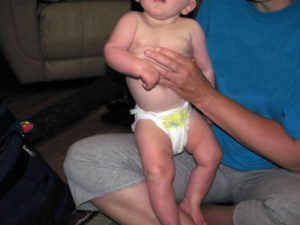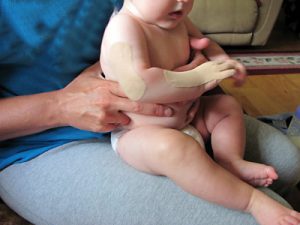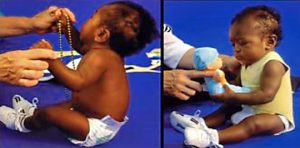Babies first explore their hands with their mouth, gradually using them to explore and reach by 3-6 months. Yet even at the stage of independent sitting, a baby can still be fascinated with those wiggly bits at the end of his arms.
Babies with an early brain or nerve injury rarely go through this early stage. They start off in the newborn period with a problem of alignment. The most common early issue is low tone or hypotonia making it hard to get the hand(s) to the mouth. Parents can help at this stage by bringing the hands to the mouth and supporting them in position. The key goal is to keep the hands in the visual field. Babies with vision problems can still “mouth” their hands and if you add a bell to a wristband, they will develop a sense of their hands in space.
If they are not supported in this early stage, they will still try to find their hand, but at the cost of “activity dependent tone”.
This baby has a right-sided brachial plexus injury that makes it difficult for her to lift her hand. When she tries, she turns on all her muscles causing her hand to fist, the elbow to flex and the shoulder to lift up. This sets off a chain reaction that stiffens her entire leg.

Back to Basics – Alignment Comes First
When I show this photo to therapists or physicians, I ask, “What is the diagnosis?” In most cases they say right-sided hemiplegia, as a child with a brain injury adopts the same posture when they try to lift the hand to the mouth. In both peripheral nerve injury and unilateral brain injury, the baby develops activity dependent tone when trying to get a damaged nervous system to work. Simple support, in this case Kinesiotape, to assist alignment, allows the infant to see and explore the hand.

Once they can be put in the upright position, trunk support is the first requirement. (Good Enough Is Not Good Enough Any More – Function Follows Form In Cerebral Palsy) The difference in function with the addition of adequate trunk support is obvious. Just as obvious is that the abnormal tone in the infant on the left is “activity dependent tone” and the vest stops it, allowing the infant to explore and learn.

I am often asked if this type of support garment leads to muscle weakness. The exact opposite is true. This type of vest allows the child to strengthen in the correct position. Your therapist can limit activity dependent tone with positioning and support from the hands. The two approaches are complementary.
Alignment leads to awareness in the baby and infant stages and it is just as necessary in the toddler and young child. If the hand is not in view, the brain will forget about it. (Developmental Apraxia Complicates BPI Recovery)
If the hand is not supported in a position of use, the child will not use it. It really is not complicated…the brain pays attention to what it sees, so our job is to facilitate use. Once the child is aware of the hand, use follows quickly.
In the older child or teenager with established maladaptive habits, the task is to create new, more useful ways of using the hand(s). This is still possible, but it takes more work. If the tone is high, you should consult with your physician and ask to see a spasticity management team. The team is important, as the best results often involve more than one modality or intervention. I have found that many are hesitant to go forward with what is actually needed to improve the hand use and I really do not understand this position. Goggle “cerebral palsy hand images” and look at the hands of older people who did not have these treatments. Why would you not take advantage of techniques that have been shown to work? Please read this blog. (Quick Fixes for 2014 – Stabilize the Wrist and Thumb) With the right support, function improves.
If the hand is still fisted over the age of about 6 years, it is not going to improve without significant help. I think part of the problem is that therapy is offered to children in defined age periods. The Birth to 3y Early Intervention therapist rarely sees the dislocated wrist of the teenager. In many regions of the world, there is little access to spasticity management, multiple forms of support, ranging from Kinesiotape to firm splints, or innovative therapy programs like Constraint Induced Movement Therapy (CIMT). CIMT has now had 22 positive randomized controlled trials in children that all showed improved function. To get the best from intensive brain retraining like CIMT, you have to have a hand and wrist that can respond. This is a very useful book. Handbook of Pediatric Constraint-Induced Movement Therapy (CIMT): A Guide for Occupational Therapy and Health Care Clinicians, Researchers, and Educators It is $99.30 on Amazon and I think every therapy center should have at least one copy. Ask your therapist and when they get it, then read it yourselves. Find out about this technique and learn to do the modified home programs yourself. This link gives you the chapter titles to whet your interest. (http://myaota.aota.org/shop_aota/prodview.aspx?Type=D&SKU=900346)
I feel like crying when I see a child manipulating the world with a fisted hand or a wrist in full flexion. These are preventable complications of growth, interacting with an immature, damaged control system. If we support them early, it need not develop. If we set up an integrated plan, taking into account all that needs to be done, form and then function can be improved. I really would ask all of the parents who have had the experience of functional change in their child or teen to write in a brief comment. If you have before and after photos of the arm and hand, I will post a gallery of them for others to see with your comments on what helped.
I cannot offer medical advice on the basis of a photo, but I am quite willing to post photos and/or videos of arm and hand position and offer advice of how I would analyze the problem. In a very real sense, this is what an athletic coach does when faced with a poorly performing athlete. The goal is to figure out the order of work to improve the individual. In the older child, producing a fast change is important to build the motivation to work for consistent gains.
Send me an email here.
kep@karenpapemd.com